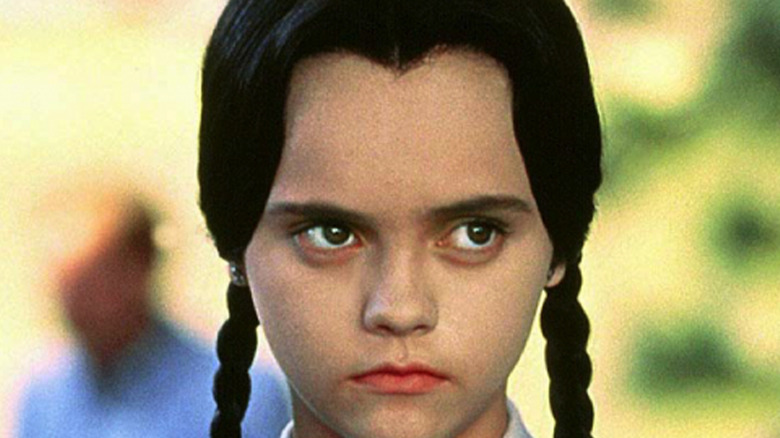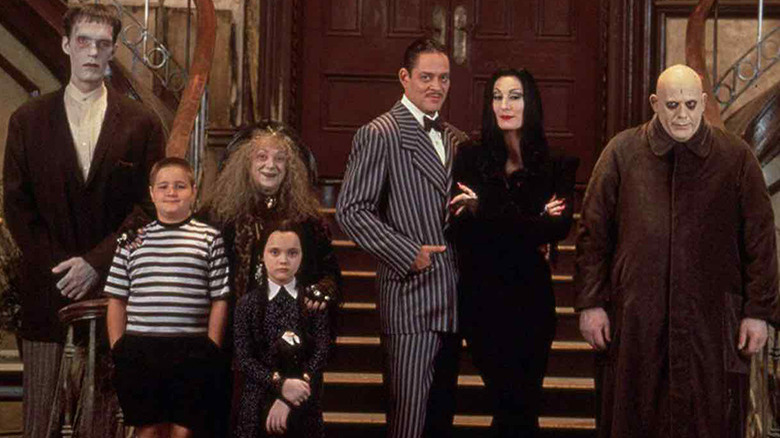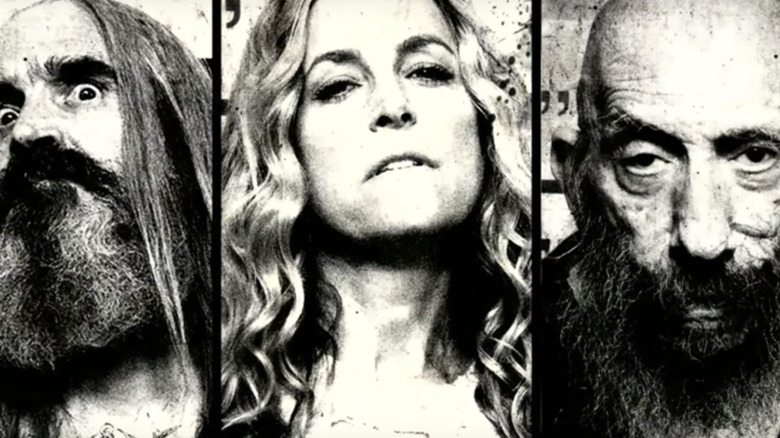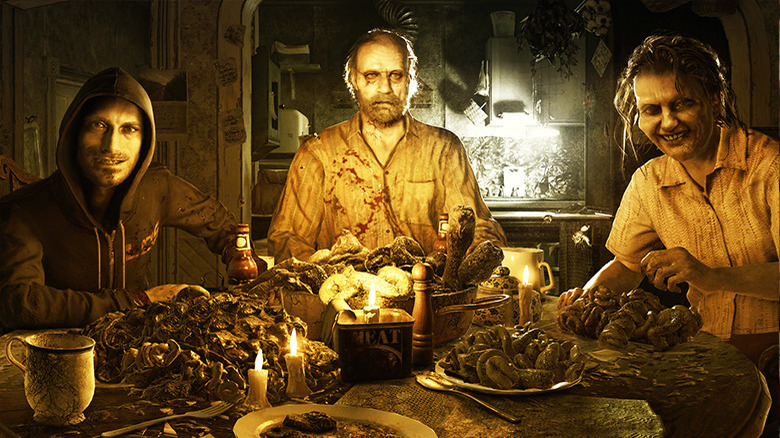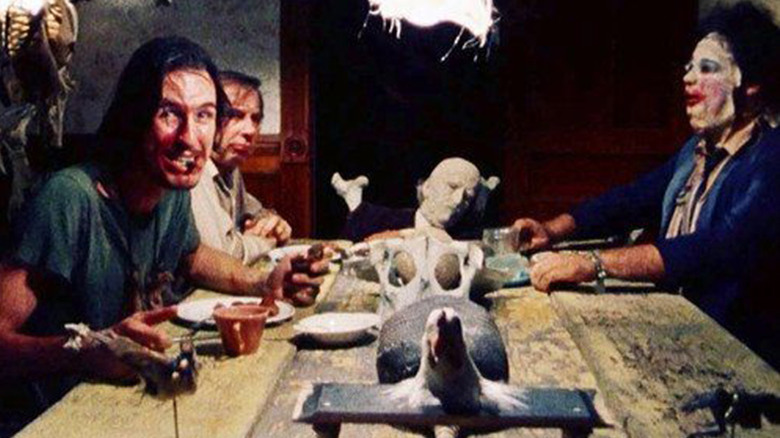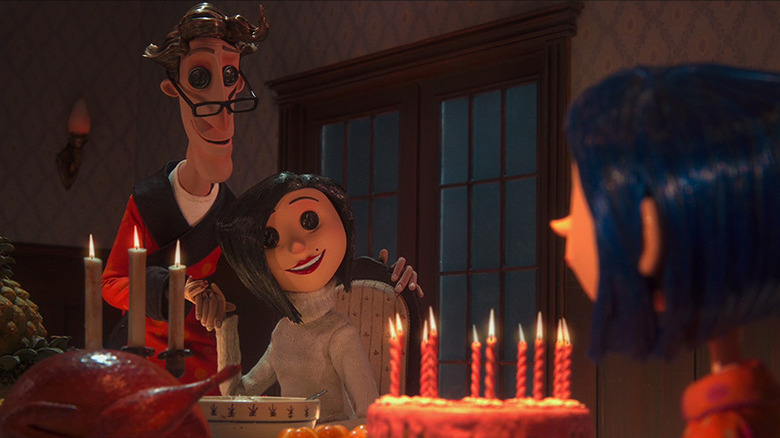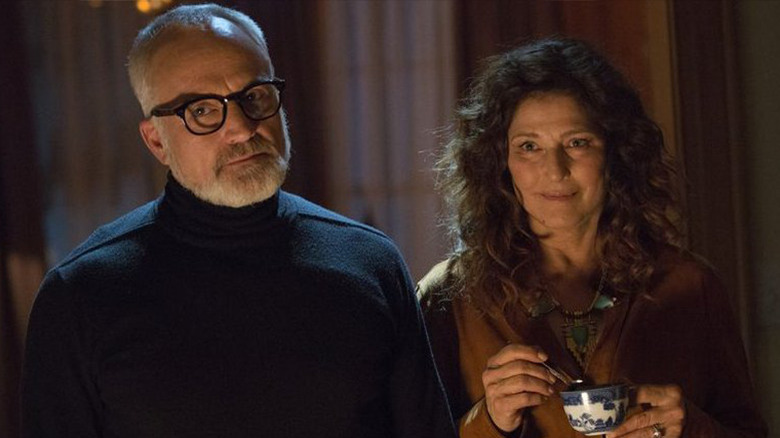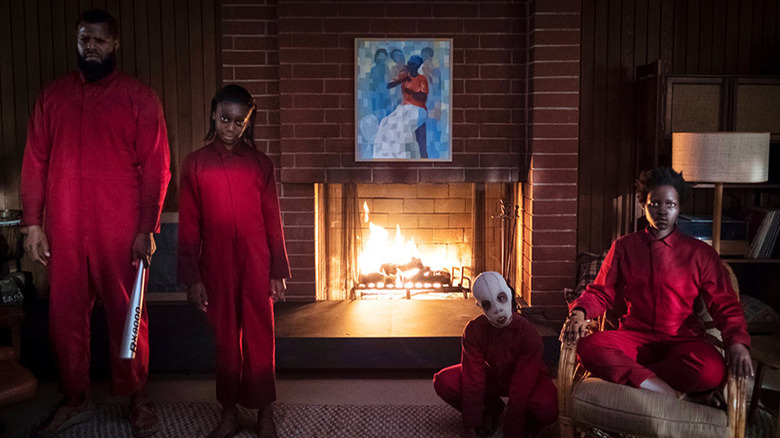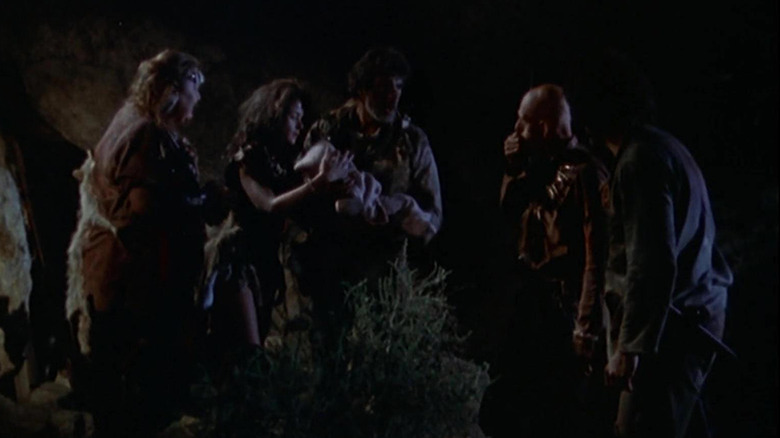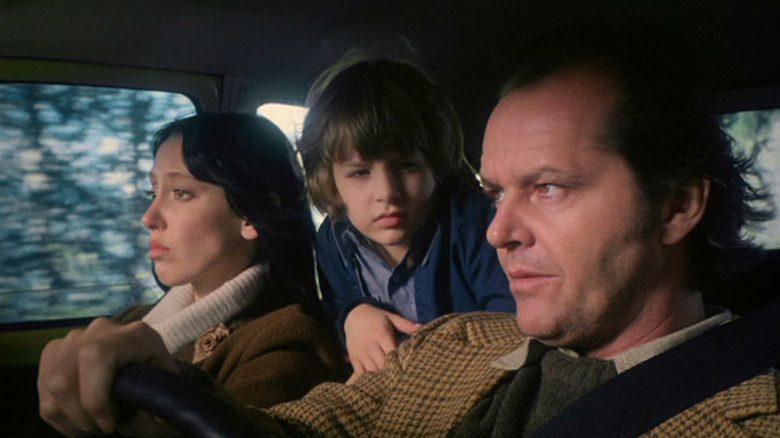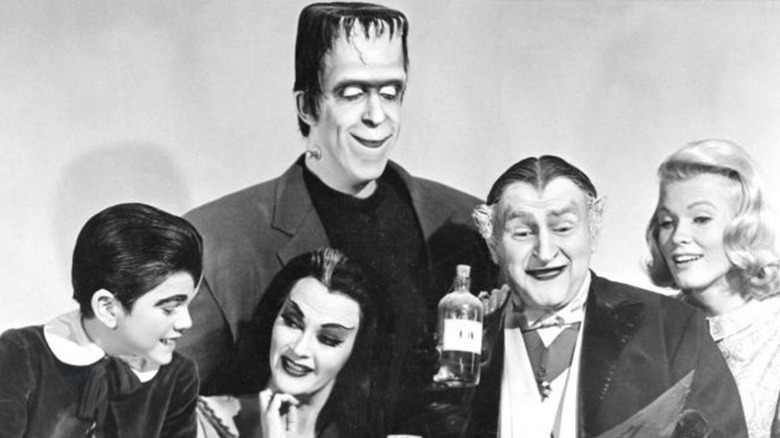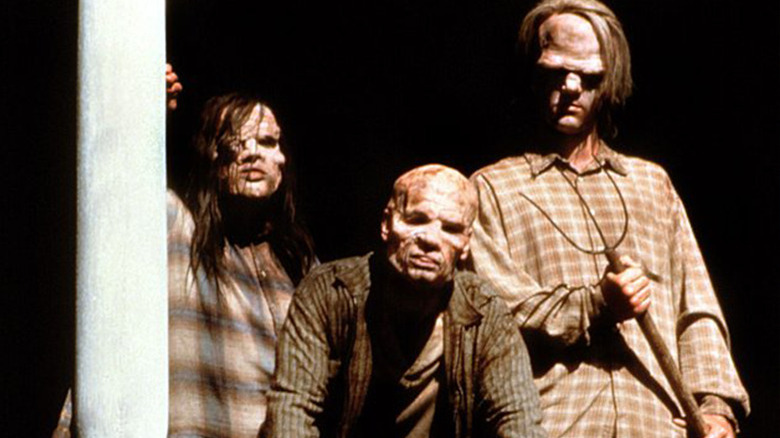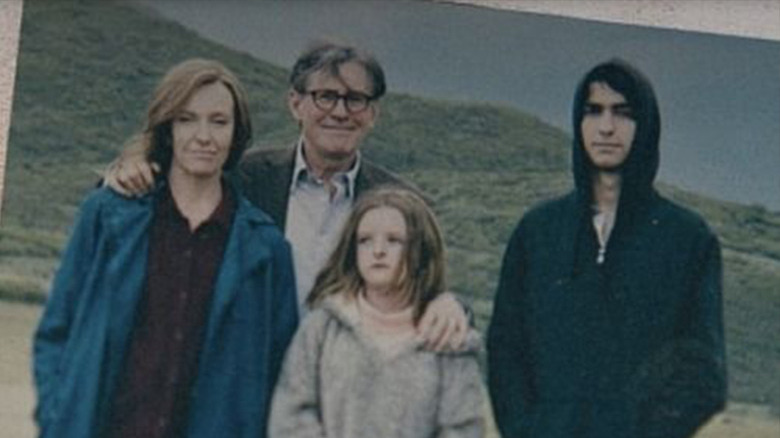Pop Culture's Freakiest Families
When it comes to pop culture, sometimes the most entertaining families are the freaky ones.
Often, these freaky families spawn from remote and isolated areas, like the Sawyer family from "Texas Chainsaw Massacre" or the Bakers from "Resident Evil 7: Biohazard", both solid examples of southern-fried horror. Other times, they emerge from the tedium of suburbia in films like "Get Out" and "Hereditary". Freaky families don't always have to be horrific or depraved (both "The Addams Family" and "The Munsters" would probably be fun to hang out with), in fact sometimes they're just the gothic weirdos or horrific monsters next door.
Yeah, you probably wouldn't want to schedule a play date with Danny Torrance. You might not want to start a sewing circle with the Other Mother. But just because these folks are freaky doesn't mean they aren't fun to watch from the safety of your own couch.
Whatever their location — or their intentions — below are some of pop culture's strangest, horrifying and thoroughly entertaining families.
The Addams Family
First created by Charles Addams for the New Yorker as an offbeat parody of the stereotypical American home, the Addams Family have proven themselves to be an indelible part of pop culture for more than 80 years. The 1964-1966 television series continues to be relentlessly charming in reruns and reissues decades after its original airing, with stars John Astin (Gomez), Carolyn Jones (Morticia) and Jackie Coogan (Uncle Fester) among those who introduced the family to the mainstream.
Another incarnation remembered fondly is the 1990s movie version, directed by Barry Sonnenfeld in a pair of films. Both 1991's "The Addams Family" and 1993's "Addams Family Values" delighted audiences with Raul Julia as Gomez, Angelica Huston as Morticia, and Christopher Lloyd as Uncle Fester. Most memorable, however, may have been 11-year-old Christina Ricci's instantly iconic performance as the true queen of goth mean, Wednesday Addams. Taken as a pair, the films were both tonally uneven and endlessly quotable.
"The Addams Family" emerged rose from the dead again in 2019, this time in an animated film featuring the voices of Oscar Isaac and Charlize Theron. Tim Burton is currently working on the latest reboot, teaming with the folks behind "Smallville" to create a live action series that may or may not include Johnny Depp.
What makes the Addams' so endearing are their sheer devotion to each other, as well as an unflinching commitment to their own individuality. Regardless of how the world views them, the characters have always been defiantly themselves. The humor of the series, in fact, often stems from just how weird the find normal people around them are.
The Fireflies (The Firefly trilogy)
Whenever you sit down to watch a Rob Zombie film, regardless of its final quality, you know that you are in for something ... well ... unique.
The "Firefly" trilogy encompasses "House of 1000 Corpses," "The Devil's Rejects" and "3 From Hell," all of which focus on the depraved, oft-hilarious Firefly family.
Due to the ever-changing style of the series, the Fireflies have gone through multiple incarnations, altering both their overall lineup and their appearances — from a family of backwoods weirdos, to a traveling trio of killers to eventual prison escapees. The members, mostly consistent through all three films, are Otis (Bill Moseley, best described as a more hands-on Charles Manson), Baby (played by Sherri Moon Zombie as beautiful, psychotic and with a tenuous grasp on reality) and Captain Spaulding (Sid Haig, perfectly cast as the Murder Ride proprietor, fried chicken enthusiast and part-time evil clown).
What makes the trio so memorable is their deranged sense of humor. There are scenes where these three partake in gleefully horrific crimes, but then they have an argument over getting ice cream. Sure, they'll disembowel you — but you might have a good chuckle or two before you shuffle off this mortal coil.
Rob Zombie built a career in cinema creating strange, disenfranchised, charming weirdos, and the Firefly Family might just be his best work.
The Bakers (Resident Evil 7: Biohazard)
With the recent release of "Resident Evil 8: Village," it can't be overstated just how its predecessor "Resident Evil 7: Biohazard" jump-started a new era in the franchise while cementing itself as a pivotal entry for modern horror video games. This was helped significantly by both the beautifully engineered first person gameplay, and the main antagonists of the game — The Baker Family.
After taking in Eveline (AKA the sentient bioweapon EV-001), the Baker — a once eccentric but kind Louisiana family — would find themselves at the mercy of evil. After being corrupted by the gift of Eveline, the trio of Jack, Marguerite and Lucas Baker become immortal, bug-puking, deathtrap-building psychopaths. This would become the central threat for the game's faceless protagonist Ethan Winters who, while traversing the vast Baker estate, must combat the entire family alongside creatures spawned from the corrupting mold.
What makes the Bakers such an entertaining group of antagonists is how each member has traits associated with famous horror films. The group as a whole is reminiscent of the Sawyers from the "Texas Chainsaw Massacre," a reference made even more explicit by their introductory dinner scene. Jack, meanwhile, is as invincible as Jason Voorhees, and Marguerite's usage of creepy crawlers feels straight of 1982's "Creepshow" movie. Further spicing up the soup is Lucas Baker's deathtraps, evocative of the "Saw" franchise.
The Sawyers (The Texas Chainsaw Massacre films)
One of horror cinema's most depraved, disgusting and disturbingly real creations blazed across screens in 1974 courtesy of the original "Texas Chainsaw Massacre" — the brainchild of Tobe Hooper, still regarded as one of the most thrillingly unnerving horror flicks ever made.
This wasn't some vampire in a gothic castle or a creature from beyond the stars. Instead, this demented clan of cannibals living in Texas felt all-too-plausible. This played into the realism of the film, the sense that a few poor life decisions and you too could be sitting down at the familial dinner table with these sickos. Factor in the film's grainy film stock aesthetic, minimalist soundtrack and horrific sound design, and you've got a film that has made a lot of people lose sleep over the last several decades.
Often mentioned in the same breath as Jason Voorhees, Michael Myers and Freddy Krueger, Leatherface (Gunner Hansen) came before any of them, bridging the gap between Norman Bates and '80s slashers. From his ever-changing skin masks to his animal-like grunts, everything about him was conveyed subtly, making for a grisly performance. Add in the Hitchhiker (Edwin Neal) and the Cook (Jim Siedow), with their corpse-like granddad in tow, and you've got a family of kooky cannibal cooks.
So many "Chainsaw" sequels, prequels and reboots have been made at this point that it's almost impossible to track all the different incarnations of the Sawyers. But this much is clear: for sheer wet-your-pants terror, nothing beats the original.
The Other Family (Coraline)
It's clear through his work that Neil Gaiman understands just because something is intended for a younger demographic doesn't mean it can't be thought provoking — and exceptionally dark.
This was especially true when it came to the film adaptation of his children's book "Coraline." The story of Coraline Jones (Dakota Fanning), a little girl spurned by her endlessly-busy parents, takes a twisted turn when she is whisked away to a mirror universe. The world contains what appears to be the bright, colorful and whimsical doppelgangers of her stick-in-the-mud parents, but life there comes with a price. It's all just a trap, created by the Other Mother (Terri Hatcher) to get a daughter of her own.
The darkness of "Coraline" stems from how it takes things previously introduced as colorful and fun (the house, her friend Wybie) and then warps them into something twisted. This includes the Other Father, introduced as a jovial, piano-playing jokester but revealed as a bloated puppet. The Beldam (as the Other Mother is also known) becomes more disturbing in appearance as the film progresses, shedding her warm, motherly facade. It all culminates with her reveal as a sickly, spider-like creature with appendages made from sewing needles.
"Coraline" is a masterfully-made, hauntingly dark fairytale — and the freaky Other Family is a big reason why.
The Armitage Family (Get Out)
There's nothing quite like meeting your significant other's parents for the first time. Awkward conversation, pretending to like dinner ... and oh yeah, the forced hypnosis as they attempt to remove your brain from your body.
Jordan Peele established himself as the fast-rising master of the horror genre with "Get Out," the 2017 Best Picture-nominated film that took its influences from such diverse fare as "The Stepford Wives" and "Rosemary's Baby." Here, he used race as the focal point, exemplified by the suspiciously-friendly Armitage Family.
When Chris Washington (Daniel Kaluuya) heads to his white girlfriend's home for a weekend visit with the potential future in-laws, he meets Dean (Bradley Whitford) and Missy (Catherine Keener), a surgeon and hypnotherapist. As the plot is peeled away like a bad onion, we learn they've indoctrinated their daughter Rose (Allison Williams) and their son Jeremy (Caleb Landry Jones) into a long-standing, cult-like community obsessed with immortality through body-theft. Carrying out these twisted acts, all with such cheerful smiles on their faces, makes the Armitage family even creepier.
The Tethered Family (Us)
You can't talk about Jordan Peele families without getting into his equally-impressive second film, 2019's "Us," in which we discovered the creepiest family of all might just be the one that looks like you.
This time, the threat was more high-concept, but no less horrific. Abandoned government clones inspired by (of all things) Hands Across America, secret underground hiding places, and many, many rabbits left audiences, well, untethered.
The counterparts of protagonist Adelaide Wilson (Lupita Nyong'o) and her family Gabe (Winston Duke), Zora (Shahadi Wright Joseph) and Jason (Evan Alex) arrive in red jumpsuits, bearing weapons and the worst of intentions. Whether mute or horribly disfigured, they represent twisted, shadow versions of the family — a revelation further amplified as Adelaide herself discovers she is actually a Tethered who was able to switch places with her counterpart during childhood.
As her traumatized counterpart militarizes the remaining Tethered for a mass invasion, things come to a fevered pitch with a bizarre, twisty ending.
The Mutant Family (The Hills Have Eyes)
Between the Sawyers and the Mutant Family, cross country travel seemed like a really bad move back in the 1970s and 1980s.
One of legendary horror director Wes Craven's most memorable creations (right alongside "A Nightmare on Elm Street" and "Scream"), 1977's "The Hills Have Eyes" was bolstered by a freaky family perfect for this list.
A family as insane and grimy as this needs a fittingly-warped origin story, which the film fills us in on. It's explained that a young Jupiter killed his family's livestock and killed his sister. Fred, the owner of Fred's Oasis, attacked Jupiter and left him to die. However, Jupiter survived and had kids with a depraved woman known as Mama. Together, they had three sons — Mars, Pluto and Mercury — as well as a daughter, Ruby. Led by "Papa Jupiter," the family survives by cannibalizing poor travelers and stealing their stuff.
The mutant family are an effective gaggle of monstrous weirdos, with the real standout of the bunch being Pluto, played by the unmistakable Michael Berryman. Pluto is the literal poster child of the original two "The Hills Have Eyes" movies, and for very good reason. He perfectly encapsulates the film's off-putting, disturbed tone.
The Torrances (The Shining)
The family from Stanley Kubrick's 1980 horror classic "The Shining" would undoubtedly be the worst to ever go on a vacation with — and considering the other families on this list, that's really saying something.
The Torrances are the protagonists of the film, itself an adaptation of a Stephen King novel. There's Danny (Danny Lloyd), a strange child dealing with telepathic abilities; his mother Wendy (Shelley Duvall), a meek woman simply hoping to keep her strained family together; rounding out the group is Jack (Jack Nicholson) a recovering alcoholic writer tasked with maintaining the Overlook Hotel in its offseason.
This family trip comes off the heels of Jack injuring Danny in a drunken outburst, which has made the family dynamic rather tense. The isolation and supernatural trickery of the hotel begins eating away at Jack, preying on his weaknesses until he snaps, going after Danny and Wendy with an axe in one of horror's most thrilling climaxes.
However you deconstruct "The Shining," it's hard to forget one of cinema's most dysfunctional, disturbed families.
The Munster Family (The Munsters)
Hitting the airwaves in 1964, "The Munsters" was a monstrous creation from "Rocky and Bullwinkle" writer/animators Allan Burns and Chris Hayward. The show, much like its competitor "The Addams Family," was a monster movie-flavored parody of the family sitcom. Both were on the air at the same time from 1964 to 1966, with the Munsters getting slightly more episodes (72 to 64) when all was said and done.
The most distinctive thing about The Munsters was that they were, well, actual monsters. Whereas the Addams Family were just spooky people, Herman (Fred Gwynne) and Grandpa (Al Lewis) were actually a Frankenstein monster and a vampire. There was also the equally macabre Lily (Yvonne De Carlo), son Eddie (Butch Patrick) and the beautiful Marilyn Munster (played by Beverley Owen, then Pat Priest) — the joke being that the rest of the family pitied her for her "normal" looks.
The show used its cast of charming monsters to lampoon standard familial tropes, like missing an anniversary, but also to comment on the modern politics of the time. In a 1964 interview with Variety, Lewis explained the hook: "Philosophically, the format is that in spite of the way people look to you physically, underneath there is a heart of gold." Like the Addams Family, the Munsters also encountered many, many "normal people" who would come to their house with a pleasant visit in mind, only to end up comically sprinting from the house in horror.
The Peacock Family (The X-Files)
A treasured staple of the 1990s will forever be "The X-Files," the show that helped bring alien conspiracy and paranormal investigation back into the mainstream.
It's only fitting that a show this significant would have a family so freaky it would result in what might have been their most controversial episode. Entitled "Home" (Season 4, Episode 2), it focuses on yet another investigation by FBI agents Dana Scully Gillian Anderson) and Fox Mulder (David Duchovny), but this time the threat is a particularly grisly one.
After investigating a deformed baby buried in a baseball field, the two agents find themselves in the crosshairs of the Peacock family, a collection of insane inbreds who'd be at home in "The Hills Have Eyes" and "The Texas Chainsaw Massacre"; the Peacocks, however, were a uniquely special case of sexual depravity and repulsive revelations. They were so repulsive, in fact, that the episode became the only one in the history of "The X-Files" to receive a TV-MA viewer discretion warning.
The Grahams (Hereditary)
Upon its release in 2018, writer/director Ari Aster's "Hereditary" was quickly praised as one of the more fascinating additions to modern horror, and its unsettling family dynamic was at the root of that praise.
The film boasted exemplary cinematography, alongside powerhouse performances including Toni Collete as mother Annie, Milly Shapiro as daughter Charlie, Gabriel Byrne as the everything-will-be-fine dad Steve and Alex Wolff as Peter, the son caught in the middle of it all.
The Grahams, at first, seemed like a typical family dealing with nothing more than an above-average amount of day-to-day oddities, most of which could be attributed to Charlie. But things got worse after the passing of Annie's mother, as we learned she had an unhealthy amount of control over the family. In no time, the wheels had been set in motion for a full-fledged cult, talk of destiny, and some gruesome deaths in the name of the demon-king Paimon.
A brutal film about the dangers of trauma, confronting the past, and letting things go, "Hereditary" also showed just how freakishly bad things could go for one ill-fated family.
